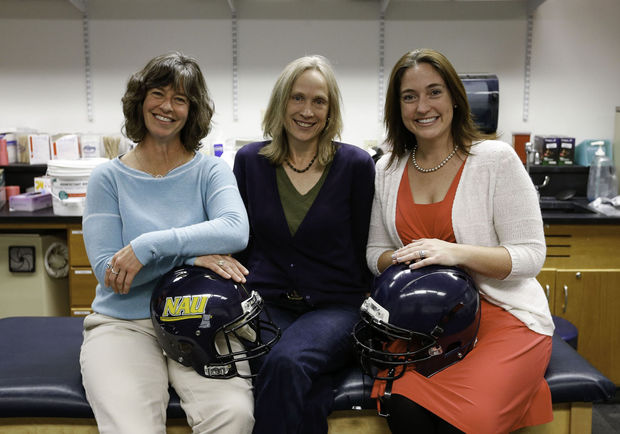
It could be because a player doesn’t want to let the team down by stepping off the field.
It could be the fear of getting pulled out of a big game.
Or it could be the pervasive misunderstanding about the severity of an injury to the head.
Whatever the reason, concussion reporting rates across the nation have hardly budged, despite a surge in policy changes, educational efforts and intensive research on the topic, a group of Northern Arizona University researchers said on Wednesday. The four professors, who come from NAU’s psychology department and its athletic training education program, are trying to tackle the issue from another angle.
Thanks to a $400,000 grant from the NCAA and the U.S. Department of Defense, the four women will examine how organizational culture influences concussion reporting and then test different strategies to boost reporting rates.
“It’s a national epidemic with the concussion issue and it’s not being solved with education,” said Debbie Craig, an athletic training education professor. “The NCAA and the Department of Defense had the foresight to say, ‘If these aren’t working then it’s most likely due to culture, so how do we change that culture?’”
NAU is one of eight universities that received grant money to research “How to spur changes in the culture surrounding concussion,” according the grant description.
The Flagstaff group’s study involves visiting four NCAA Division I football programs five times each over the span of two and a half years. They aren’t releasing the names of the schools because the anonymity allowed them to gain access to the universities and helps preserve the accuracy of their results, the researchers said.
The first visit to each university will be spent conducting player surveys, interviewing coaches and observing practices, games and places where the athletes spend time like locker rooms and meeting rooms. The women also will run association tests to gain insight into players’ subconscious beliefs about things like big hits on the field or head injuries, said Ann Huffman, an associate professor in the College of Social and Behavioral Sciences and the W. A. Franke College of Business and chair of the university’s intercollegiate athletics committee.
Pilot research the researchers already did in Arizona found that there are multiple reasons for low concussion reporting rates. Those include misconceptions among athletes about how hurt they are, a sense of brotherhood that discourages reporting on a teammate who looks concussed, and a misunderstanding that a person has to lose consciousness to experience a concussion.
In fact, only 10 percent of concussed cases lose consciousness, said Monica Lininger, an assistant professor in the athletic training education program.
After gathering that baseline data on concussion culture within each program, the NAU research team will develop specialized intervention strategies for each school, then sit down with representatives from each program to see which suggestions they like and what other ideas they may have to address the problem. Research has shown that allowing participant input, instead of imposing the ideas brainstormed by researchers, facilitates creative ideas and buy-in, said Heidi Wayment, a professor of social psychology who has years of athletic experience as a college and professional basketball player.
A possible intervention might be identifying one or two influential people within the team and working with each individual to lead by example in terms of taking concussions seriously and reporting them, Craig said. Another idea might be removing photos or posters that appear to celebrate violent play on the field, Lininger said.
Suggestions for changes may also involve piggybacking on the positive values, like hard work, camaraderie and sacrifice, that athletes and teams already carry, Wayment said.
“It will be helpful for us to understand what motivates them to do this very very exhilarating and difficult work,” she said. “Maybe some of those same values can help nudge behavior in a way that might help them with their own safety and health and their teammates.”
The final three visits to each university, which will kick off in the fall of 2017, will be a pre-intervention assessment, a post-intervention assessment to look for changes in behavior or in the players’ environment, and then a visit to present the study’s results and ask for feedback.
The women’s hope is that their research will provide useful insights for not only college football players but other athletes and age groups as well. Ideally, their recommendations will inspire athletic policy changes among institutions, conferences and even the NCAA, they said.
“We can do research that makes a difference,” Huffman said.